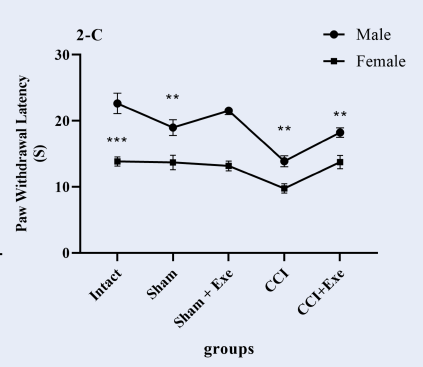Exercise-induced improvement of neuropathic pain in rats: Possible role of oxidative stress
DOI:
https://doi.org/10.15419/bmrat.v10i6.813Keywords:
Exercise, Neuropathic pain, Oxidative stress, RatAbstract
Introduction: Neuropathic pain is one of the main problems that succeeds a lesion or disease of the somatosensory system. In this study, the effect of exercise on oxidative stress after neuropathic pain due to sciatic nerve injury in male and female rats was evaluated.
Methods: For this study, 70 adult wistar rats (35 males and 35 females) weighing 180 ? 220 grams were divided into single-sex intact, sham, exercised sham, neuropathy, and exercised neuropathy groups, with 7 rats in each group. To induce neuropathy, chronic constriction injury (CCI) of the sciatic nerve was used. The exercise program included 4 weeks of swimming and medium-intensity. Von-Frey filament and plantar test devices were used to evaluate neuropathic pain. Malondialdehyde (MDA) and the ferric-reducing ability of plasma (FRAP) were determined using a spectrophotometer.
Results: Our results showed that nerve damage significantly reduced the response threshold to mechanical and thermal stimulation in both sexes, and continuous exercise significantly improved neuropathic pain in both sexes. In addition, nerve injury did not significantly generate oxidative stress in male or female rats. Meanwhile, exercise significantly reduced MDA levels and increased FRAP levels in neuropathic male rats but it did not affect oxidative stress parameters in female neuropathic rats.
Conclusions: Long-term exercise reduces neuropathic pain. Swimming exercise significantly modified MDA and FRAP levels in neuropathic male rats but not in female rats. Sex hormones appear to play different roles in the oxidative stress response.

Published
Issue
Section
License
Copyright The Author(s) 2017. This article is published with open access by BioMedPress. This article is distributed under the terms of the Creative Commons Attribution License (CC-BY 4.0) which permits any use, distribution, and reproduction in any medium, provided the original author(s) and the source are credited.
